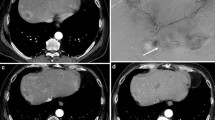Abstract
Objectives
Metastatic breast cancer is a heterogeneous disease, commonly affecting the liver. We report our experience with 90Y radioembolisation (RE) and its effects on the survival of patients with treatment-refractory breast cancer liver metastases.
Methods
A total of 77 female patients affected by breast cancer were accepted into our department for RE. Inclusion criteria were inoperable and chemotherapy-refractory hepatic metastases, acceptable performance status, sufficient residual liver, no significant hepato-pulmonary shunts. Patients were divided in two groups: group 1 (29 patients) included those with Eastern Cooperative Oncology Group (ECOG) score 0, liver involvement (0–25 %) and no extrahepatic disease (EHD); group 2 (23 patient) included patients with ECOG score 1–2, liver involvement (26–50 %) and evidence of EHD.
Results
A total of 25 patients were considered ineligible. The median age of the remaining 52 patients was 57.5 years. The median overall survival was 11.5 months and better in those whose performance status and liver function were preserved (14.3 versus 8.2 months). According to Response Evaluation Criteria in Solid Tumor (RECIST), partial response (PR) was achieved in 29 patients (56 %), stable disease (SD) was achieved in a further 18 patients (35 %) and 5 patients showed progressive disease (PD) (10 %).
Discussion
90Y RE is effective in the treatment of liver metastases from breast cancer. We demonstrated a relevant survival and encouragingly high response rate in patients with treatment-refractory disease.
Key Points
• Interventional radiological techniques are increasingly used for metastatic disease in the liver.
• 90 Y radioembolisation (RE) seems effective for treating hepatic metastases from breast cancer.
• RE is safe and well tolerated when performance status and liver function are preserved.





Similar content being viewed by others
Abbreviations
- BSA:
-
body surface area
- ECOG:
-
Eastern Cooperative Oncology Group
- EBRT:
-
external beam radiation therapy
- FISH:
-
fluorescent in situ hybridisation
- HRs:
-
hormonal receptors
- IHC:
-
immunohistochemistry
- mBC:
-
metastatic breast cancer
- PD:
-
progressive disease
- PR:
-
partial response
- RE:
-
radioembolisation
- RECIST:
-
Response Evaluation Criteria in Solid Tumor
- RF:
-
radiofrequency
- RILD:
-
radiation-induced liver disease
- SD:
-
stable disease
- TACE:
-
transarterial chemoembolisation
References
Andre F, Slimane K (2004) Breast cancer with synchronous metastases: trends in survival during a 14-year period. J Clin Oncol 22:3302–3308
Giordano SH, Buzdar AU (2004) Is breast cancer survival improving? Cancer 100:44–52
Miller KD, Sledge GW Jr (1999) The role of chemotherapy for metastatic breast cancer. Hematol Oncol Clin North 13:415–434
Stockler M, Wilcken NR (2000) Systematic reviews of chemotherapy and endocrine therapy in metastatic breast cancer. Cancer Treat Rev 26:151–168
Adam R (2003) Chemotherapy and surgery: new perspectives on the treatment of unresectable liver metastases. Ann Oncol 14:ii13–ii16
Hoffmann R, Jakobs TF (2010) Radiofrequency ablation after selective internal radiation therapy with yttrium90 microspheres in metastatic liver disease—is it feasible? Eur J Radiol 74:199–205
Bangash AK, Atassi B (2007) 90Y radioembolization of metastatic breast cancer to the liver: toxicity, imaging response, survival. J Vasc Interv Radiol 18:621–628
Campbell AM, Bailey IH (2000) Analysis of the distribution of intra-arterial microspheres in human liver following hepatic yttrium-90 microsphere therapy. Phys Med Biol 45:1023–1033
Gulec S, Mesoloras G (2007) Safety and efficacy of Y-90 microsphere treatment in patients with primary and metastatic liver cancer: the tumor selectivity of the treatment as a function of tumor to liver flow ratio. J Transl Med 5:15
Breedis C, Young G (1954) The blood supply of neoplasms in the liver. Am J Pathol 30:969–974
Taylor I, Bennett R, Sherriff S (1979) The blood supply of colorectal liver metastases. Br J Cancer 39:749–756
Jakobs T, Hoffmann R-T (2008) Radioembolization in patients with hepatic metastases from breast cancer. J Vasc Interv Radiol 19:683–690
Kennedy A, Nag S (2007) Recommendations for radioembolization of hepatic malignancies using yttrium-90 microsphere brachytherapy: a consensus panel report from the radioembolization brachytherapy oncology consortium. Int J Radiat Oncol Biol Phys 68:13–23
Coldwell DM, Kennedy AS (2007) Use of yttrium-90 microspheres in the treatment of unresectable hepatic metastases from breast cancer. Int J Radiat Oncol 69:800–804
Cianni R, Urigo C (2010) Radioembolisation using yttrium 90 (Y-90) in patients affected by unresectable hepatic metastases. Radiol Med 115:619–633
Jakobs TF, Hoffmann RT (2008) Hepatic yttrium-90 radioembolization of chemotherapy-refractory colorectal cancer liver metastases. J Vasc Interv Radiol 19:1187–1195
Author information
Authors and Affiliations
Corresponding author
Rights and permissions
About this article
Cite this article
Cianni, R., Pelle, G., Notarianni, E. et al. Radioembolisation with 90Y-labelled resin microspheres in the treatment of liver metastasis from breast cancer. Eur Radiol 23, 182–189 (2013). https://doi.org/10.1007/s00330-012-2556-5
Received:
Revised:
Accepted:
Published:
Issue Date:
DOI: https://doi.org/10.1007/s00330-012-2556-5




